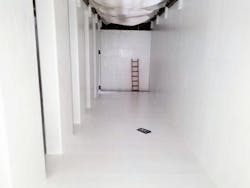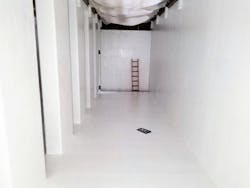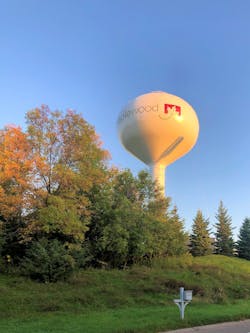Sherwin-Williams announces 2020 Water & Wastewater Impact Award winners
CLEVELAND (December 3, 2020) – A labor-intensive restoration of eight deteriorated membrane bioreactor (MBR) basins for the South Valley Sewer District (SVSD) Jordan Basin Water Reclamation Facility in Bluffdale, Utah, has earned the facility and project team the 2020 Sherwin-Williams Impact Award. The award recognizes exceptional projects that feature high-performance coating and lining materials from Sherwin-Williams Protective & Marine. The project involved restoring the concrete basins and applying a durable, fiberglass-reinforced lining system designed to prevent future deterioration. The winning team includes the SVSD, general contractor CDC Restoration & Construction, and Bowen, Collins & Associates, which served as the project’s engineering and coating inspection firm.
A similar endeavor featuring a different lining solution for MBR basins was named the runner-up project. Applicators from Champion Coatings installed a flexible polyurethane lining system in five newly installed basins at the Grand Forks Regional Water Treatment Plant for the City of Grand Forks, North Dakota. In addition, Traill Painting Company coated a wide array of assets for the plant, including applying a heavy-duty, graphite-filled lining system on a secondary containment vessel, installing resinous flooring throughout the facility, and coating pipes, tanks, walls, doors and numerous other structures. Additional project members included civil/environmental consulting engineering firm AE2S and engineering and construction firm Ulliman Schutte Construction.
The honorable mention project focused on the potable water storage side of the water and wastewater industry. It involved the inside and outside restoration of a 500,000-gallon water tower for Saint Paul Regional Water Services in St. Paul, Minnesota. Inside the tower, applicators from TMI Coatings installed a zinc/epoxy/epoxy lining system that had recently secured industry approval for potable water storage, making this the first tower to feature the interior lining. In addition, applicators used a zinc/epoxy/polyurethane system with excellent color and gloss retention on the exterior. Consulting services firm Short Elliott Hendrickson Inc. (SEH®) served as the engineering and coatings inspection firm for the project.
“When we review applications for the Sherwin-Williams Impact Award each year, we’re always very impressed by the applicants’ commitment to finding optimal solutions to water and wastewater challenges. As we see in this year’s first place and runner-up projects, there are multiple ways to address similar challenges, with the best solution dependent on the particular project,” said Murray Heywood, North America Market Manager, Water & Wastewater, Sherwin-Williams Protective & Marine. “Through the Impact Award program, we take pride in honoring the problem solvers who find ways to ensure the proper care and upkeep of critical water and wastewater infrastructure to continually deliver safe, reliable service in communities across North America.”
The Sherwin-Williams Impact Award program recognizes application contractors, specifiers and owners for excellence on North American water and wastewater projects that have a compelling effect on the industry with regard to public safety, asset protection and infrastructure life cycle improvement. Eligible projects included any water-related structure that was new, restored and/or rehabilitated in 2019 and was completed using coating and lining materials from Sherwin-Williams Protective & Marine.
FIRST PLACE: Robust Lining System Restores Membrane Bioreactor Basins to Like-New ConditionAs the South Valley Sewer District (SVSD) in Bluffdale, Utah, planned and designed its new Jordan Basin Water Reclamation Facility (JBWRF), project managers pondered a common question: to line or not to line the eight concrete basins that make up the facility’s membrane bioreactor (MBR) system. Ultimately, budgetary restrictions drove the decision to wait on the linings and address them after the concrete degraded from use. That deterioration came a bit faster than anticipated as the corrosive membrane filter cleaning process caused the loss of one-quarter to three-quarter inches of concrete throughout the basins within about six years of service. There was no question now – it was time to line the basins.
The project would require investigating the corrosion problem, extensively evaluating potential coating systems and developing a contract addressing materials, procedures and quality control for the restoration work. SVSD retained Bowen Collins & Associates (BC&A) as the design engineer for the project. BC&A engaged Corrosion Control Technologies, a corrosion engineering firm based in Sandy, Utah, as a subconsultant to assist with the work. Following the firms’ completion of the design investigation and rehabilitation specifications, SVSD put the contract out for bid and selected Salt Lake City, Utah-based CDC Restoration & Construction to complete the work. The contractor then restored the concrete and applied a durable, non-permeable lining system from Sherwin-Williams Protective & Marine, returning the basins to like-new condition with a durable barrier that will protect the concrete from wear for far longer than when it was unlined.
Concrete in the JBWRF’s MBR basins had severely degraded due to chemical attack caused by cleaning agents used to clean the MBR filters. The citric acid and sodium hypochlorite used to remove unwanted elements from the filter membranes had progressively eaten away at the unlined basin walls. CDC Restoration & Construction performed a variety of rehabilitation steps, including preparing the concrete for repairs, restoring its surface to its original plane, applying a moisture remediation primer, adding a fiberglass mat-reinforced epoxy laminate system and applying a protective epoxy lining.
After applicators from CDC Restoration & Construction vapor abrasive blasted the concrete to create a clean surface for coating applications, project engineers knew moisture would be an issue for the lining application, as adjacent basins remained full of water. Moisture would therefore be able to migrate through the concrete on at least one wall in each basin undergoing repairs, creating potential adhesion issues. The team remedied this issue by spray applying the basin walls with Resuprime™ MVT, a two-component, fast-curing epoxy resin from Sherwin-Williams. The surface membrane is tolerant of residual moisture in concrete and served to block moisture migration to the concrete’s surface, enabling its restoration.
Applicators were able to begin repairing the deteriorated concrete about 12 hours after applying the Resuprime MVT moisture-control coat. Using Steel-Seam™ FT910, a 100% solids epoxy patching and surfacing compound from Sherwin-Williams, they repaired cracks, filled voids, bugholes and honeycombs, and rebuilt the deteriorated concrete surfaces to their original dimensions.
With the concrete built back to an even plane, applicators turned to the reinforced lining system application. That included applying a base layer of Sherwin-Williams Dura-Plate® UHS Clear Laminate topped with a 1.5-ounce fiberglass mat that was then sealed with more of the clear laminate material before being topcoated with Dura-Plate UHS Epoxy White. The two ultra high-solids epoxy amine coatings are engineered specifically for use as laminating systems in immersion service and provide superior protection via their high-build, edge-retentive properties.
As a quality control efficiency, the engineering team devised a clever solution that would help inspectors – both during the lining application process and later when examining the lining for damage during periodic service inspections. They used a green-tinted hardener with the clear laminate, which made it easier for applicators and inspectors to ensure the fiberglass matting was fully wetted during applications. When applying the white topcoat, applicators were also able to ensure a uniform, pinhole-free final film by fully covering the contrasting green layer. In addition, the color contrast is helping inspectors examine basins following service, as any visible green spots indicate damage to the topcoat.
Following inspection by staff from BC&A, each basin was approved for use before applicators moved onto the next one. The protocol of applying the moisture-mitigation coat, surfacing compound, tinted base epoxy layer and white top coat enabled the time-consuming project to proceed quickly. The team was able to restore all eight MBR basins in about 57 weeks – well within the 60-week completion time frame. Best of all, the 15-MGD (million gallons per day) facility was able to remain in operation throughout the project, enabling it to continue serving the surrounding area with water filtered for use in secondary irrigation systems.
RUNNER-UP: Coating Systems Enable Time Savings for North Dakota Water Treatment Plant Construction
When building an expansive new water treatment plant, keeping the project timeline on track is critical. This focus on timeliness prompted project managers for the new Grand Forks Regional Water Treatment Plant (GFRWTP) to make strategic coating selections that removed days from various applications performed during the project. For example, shifting from a five- to six-coat lining system to a one-coat system from Sherwin-Williams Protective & Marine saved applicators at least an entire day for each of the five membrane bioreactor (MBR) basins they lined. That and other efficiencies ultimately saved the crew more than two weeks of lining installation time for the basins. In addition, because flooring installers were able to apply two top coat layers in the same day, they saved a day on every area coated with resinous flooring throughout the GFRWTP.
The new GFRWTP for the City of Grand Forks, North Dakota, is a $153-million endeavor designed to upgrade the city’s water treatment processes and daily volume capacity. The plant features an MBR process that treats water for use in irrigation systems. The process requires periodic cleaning using citric acid and sodium hypochlorite to remove contaminants from system filters. These agents create heat and are highly corrosive, requiring MBR basins to be lined with protective coatings to preserve their concrete structures.
Options for lining MBR basins included an originally specified five- to six-coat system, which consists of a concrete resurfacer, moisture barrier, epoxy base coat, fiberglass mat and an epoxy top coat. However, this system is time consuming and labor intensive to install, requiring about three days to line a roughly 25-foot-wide by 30-foot-long basin. With all eyes on efficiency, the project team opted to use Poly-Cote™ 115 from Sherwin-Williams, as the system could be applied and ready for service in less than two days and with an easier spray application. The 100% solids, elastomeric polyurethane features optimal build properties that enabled applicators to spray the coating at the same thickness as the five- to six-coat system in a single pass. This alone represented a one-day savings per basin.
To line the concrete basins, applicators from Prior Lake, Minnesota-based Champion Coatings first sandblasted the concrete to the SSPC-SP 13/NACE No.6 standard. Next, they applied Dura-Plate® 2300, an epoxy-modified cementitious resurfacer from Sherwin-Williams, to fill in any imperfections in the concrete and create a hard, durable surface with excellent adhesion for the lining system. Further ensuring adhesion, applicators next applied a primer coat of Dura-Plate 235 to the resurfaced concrete. This layer served as a barrier to prevent moisture and air in the concrete from escaping and creating pinholes in the lining. Due to the fast return-to-service time for Dura-Plate 2300, as well as no need to complete a sweep blast on the resurfacer before coating it, Champion Coatings was able to complete the resurfacing and primer applications on the same day.
The next day, applicators applied the Poly-Cote 115 lining system, spraying the coating between 65 and 100 mils dry film thickness (DFT) in a single pass for a high-build lining that has the same thickness in one coat as the originally specified multicoat system. Using the Poly-Cote 115 lining system, Champion Coatings was able to fully line each basin within two days – and sometimes even all on the same day. Applicators would have needed at least three or more days when using the five- to six-coat system.
Continuing with the mandate for efficiency, applicators from Fargo, North Dakota-based Traill Painting installed more than 15,000 square feet of resinous flooring throughout the GFRWTP and saved a day for each area coated due to the product selection. The flooring system included a primer coat of Sherwin-Williams® 3579, covered with an intermediate coat of Sherwin-Williams 3746 High-Performance Epoxy and topped with two coats of Sherwin-Williams 4850 Polyaspartic Floor Coating SS. Application efficiencies drove the top coat material choice, as the fast-curing, high-solids polyaspartic resin allowed installers to apply a second coat within six hours after the first coat. As a result, Traill Painting could complete both top coat layers in the same day, shortening the installation timeline.
The GFRWTP project also involved applying a heavy-duty, graphite-filled lining system on a secondary containment vessel designed to capture hydrofluorosilicic acid should the material’s primary storage tank fail. Applicators from Traill Painting first prepared the concrete vessel’s surface to remove contaminants and then primed it with Sherwin-Williams Corobond® Vinyl Ester Primer to promote adhesion of the top layers. Next, the crew applied Poly-Glass™ Putty resurfacing compound from Sherwin-Williams to fill in any voids and bugholes in the concrete surface before applying two coats of Sherwin-Williams Cor-Cote® VEN GF to protect the containment area. Specifiers chose this graphite-filled epoxy novolac-based vinyl ester due to its resistance to hydrofluorosilicic acid.
HONORABLE MENTION: Lining System Enables Fast Return to Service for Minnesota Water Storage Tower
The team chose to apply Sherwin-Williams Dura-Plate® 6000, a durable, 100% solids glass-flake reinforced lining system that offered a return-to-service time of just 10 hours following the final application. The high-build, high-strength reinforced epoxy lining system had just completed NSF/ANSI/CAN 600 testing, making it an excellent choice for a potable water tower lining. With the project commencing in September, the fast-curing coating would enable TMI Coatings to complete the lining application in late fall in Minnesota. In addition, the glass-flake reinforced lining would also provide a life expectancy greater than a conventional three-coat zinc/epoxy/epoxy system due to the coating’s extremely low permeability and excellent abrasion resistance.
To install the lining system inside the spheroidal Sterling Ave. tower, a crew from TMI Coatings first prepared the interior tank surfaces to the SSPC SP-10/NACE No. 2 near-white metal blast cleaning standard. Next, crewmembers applied a stripe coat of Sherwin-Williams Corothane® I GalvaPac 1K Zinc Primer to welds before spraying a full coat on the interior surfaces at 2 to 4 mils dry film thickness (DFT). This moisture-curing urethane zinc-rich primer provides resistance to corrosion and enables cathodic protection to help protect the tank’s steel from deteriorating. Applicators then sprayed the reinforced Dura-Plate 6000 lining at 30 to 40 mils DFT in a single coat using plural spray equipment, with the ability to spray up to 125 mils DFT to fill in any pits. TMI Coatings had the option to spray the high-build coating using single-leg equipment but opted to spray the tank using a plural component spray pump due to the elevation inside the tank and the number of gallons needed for the project.
Aesthetics were the focus for the water tower’s exterior, prompting the team to specify Sherwin-Williams Acrolon™ Ultra for the tank’s top coat. The high-performance acrylic polyurethane offers exceptional long-term color and gloss retention, as well as excellent resistance to corrosion and weathering. It can also be applied at thinner DFTs of just 2 to 3 mils compared to 3 to 5 mils for conventional polyurethanes. Applicators from TMI Coatings first prepared the tank’s exterior to the SSPC SP-6/NACE No. 3 commercial blast cleaning standard and then applied a 2- to 4-mil DFT primer coat of Corothane I GalvaPac. Next, they applied an intermediate coat of Macropoxy® 646 Fast Cure Epoxy at 4-6 mils DFT as a protective layer before adding the Acrolon Ultra topcoat. For the finishing touches, applicators hand painted a logo featuring the Maplewood community name and an artistic maple leaf drawing. To ensure long-term color and gloss retention for the brown and maroon logo, applicators used Fluorokem® HS 100, a premium, ultra-durable fluoropolymer urethane finish that offers superior exterior durability.
Upon completion of the coating applications, the tower rehabilitation project faced its final test – a discerning panel of taste testers that had to approve water samples from the newly lined and filled tank before it could be approved for servicing the Maplewood community. No tank has passed the panel on the first try in about 15 years. If the panel expressed any taste or odor concerns, Saint Paul Regional Water Services would need to drain and refill the tank – perhaps multiple times – until the panel approved the new samples, with each draining of the tank wasting water, time and money. Given the 100% solids lining system’s chemistry, the project team had no worries about the test. Still, the team was relieved to learn the panel passed the first samples without hesitation, enabling Saint Paul Regional Water Services to place the tank online immediately thereafter.
The utility provider returned the tower to service just 30 days after starting the restoration. This timing was possible due to the easy application and fast-curing properties of Dura-Plate 6000 for the lining, as well as the streamlined exterior coating system application. In addition, the taste panel’s approval of water samples from the first tower fill enabled immediate service, proving the project team made the right choice in specifying the new lining system.



